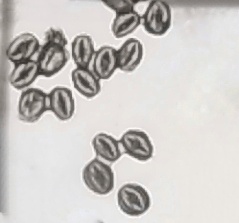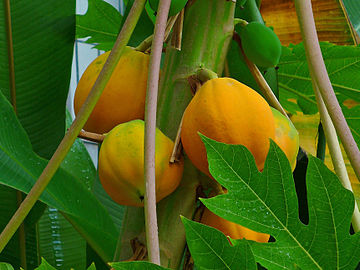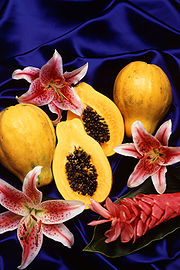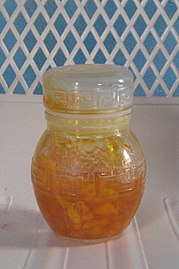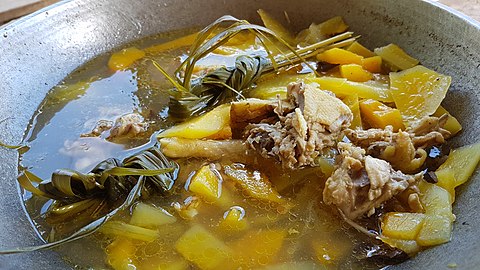Papaya
| Papaya | |
|---|---|

| |
| Plant and fruit, from Koehler'sMedicinal-Plants(1887) | |
| Scientific classification | |
| Kingdom: | Plantae |
| Clade: | Tracheophytes |
| Clade: | Angiosperms |
| Clade: | Eudicots |
| Clade: | Rosids |
| Order: | Brassicales |
| Family: | Caricaceae |
| Genus: | Carica |
| Species: | C. papaya
|
| Binomial name | |
| Carica papaya | |
Thepapaya(/pəˈpaɪə/,US:/pəˈpɑːjə/),papaw,(/pəˈpɔː/[3]) orpawpaw(/ˈpɔːpɔː/[3])[4]is theplantspeciesCarica papaya,one of the 21 accepted species in thegenusCaricaof the familyCaricaceae,[5]and also the name of its fruit. It was first domesticated inMesoamerica,within modern-day southernMexicoandCentral America.[6][7]It is grown in several countries in regions with a tropical climate. In 2022,Indiaproduced 38% of the world's supply of papayas.
Etymology[edit]
The wordpapayaderives fromArawakviaSpanish,[8]and is also the name for the plant. The namepapaworpawpawis used alternatively for the fruit only in some regions.[6][9]
Description[edit]
The papaya is a small, sparsely branchedtree,usually with a singlestemgrowing from 5 to 10 m (16 to 33 ft) tall, withspirallyarrangedleavesconfined to the top of thetrunk.The lower trunk is conspicuouslyscarredwhere leaves and fruit were borne. The leaves are large, 50–70 cm (20–28 in) in diameter, deeplypalmatelylobed, with seven lobes. All plant parts containlatexin articulatedlaticifers.[10]
-
Seedlings
-
Coiledphyllotaxyof papaya leaves
-
Leaf
Flowers[edit]
Papayas aredioecious.Theflowersare five-parted and highly dimorphic; the male flowers have the stamens fused to the petals. There are two different types of papaya flowers. The female flowers have a superior ovary and five contorted petals loosely connected at the base.[11]: 235
Male and female flowers are borne in the leaf axils; the male flowers are in multiflowereddichasia,and the female ones are in few-flowered dichasia.[citation needed]The pollen grains are elongated and approximately 35 microns in length.[citation needed]The flowers are sweet-scented, open at night, and are wind- or insect-pollinated.[10][12][13]
Fruit[edit]
The fruit is a largeberryabout15–45 cm (6–17+3⁄4in) long and10–30 cm (4–11+3⁄4in) in diameter.[10]: 88 It isripewhen it feels soft (as soft as a ripeavocadoor softer), its skin has attained an amber to orange hue and along the walls of the large central cavity are attached numerous black seeds.[14]
-
Unripe fruit
-
Mature tree with unripe fruit inKinshasa
-
Ripe fruit
-
Papayas with yellow flesh
-
Longitudinal section of fruit showing orange flesh and numerous black seeds
-
Papaya seeds
| NCBIgenome ID | 513 |
|---|---|
| Ploidy | diploid |
| Genome size | 372 million bp |
| Number ofchromosomes | 36 |
| Year of completion | 2014 |
Chemistry[edit]
Papaya skin, pulp, and seeds contain a variety ofphytochemicals,includingcarotenoidsandpolyphenols,[15]as well asbenzyl isothiocyanatesand benzyl glucosinates, with skin and pulp levels that increase during ripening.[16]The carotenoids,luteinandbeta-carotene,are prominent in the yellow skin, whilelycopeneis dominant in the red flesh (table).[17]Papaya seeds also contain thecyanogenicsubstanceprunasin.[18]The green fruit containspapain,[6]acysteine proteaseenzyme used totenderizemeat (seebelow).
Distribution and habitat[edit]
Native to tropical America, papaya originates from southern Mexico and Central America.[6][7][10]Papaya is also considered native to southernFlorida,introduced by predecessors of theCalusano later than AD 300.[19]Spaniards introduced papaya to theOld Worldin the 16th century.[6]Papaya cultivation is now nearlypantropical,spanning Hawaii, Central Africa, India, and Australia.[6]
Wild populations of papaya are generally confined to naturally disturbed tropical forests.[7]Papaya is found in abundance onEvergladeshammocksfollowing major hurricanes, but is otherwise infrequent.[19]In the rain forests of southern Mexico, papaya thrives and reproduces quickly in canopy gaps while dying off in the mature closed-canopy forests.[7]
Ecology[edit]
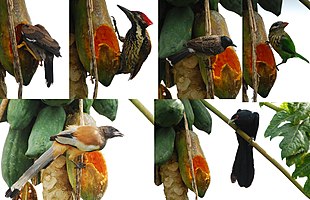
Viruses[edit]
Papaya ringspot virusis a well-known virus within plants in Florida.[6]The first signs of the virus are yellowing and vein-clearing of younger leaves and mottling yellow leaves. Infected leaves may obtain blisters, roughen, or narrow, with blades sticking upwards from the middle of the leaves. The petioles and stems may develop dark green greasy streaks and, in time, become shorter. The ringspots are circular, C-shaped markings that are a darker green than the fruit. In the later stages of the virus, the markings may become gray and crusty. Viral infections impact growth and reduce the fruit's quality. One of the biggest effects that viral infections have on papaya is taste. As of 2010, the only way to protect papaya from this virus isgenetic modification.[20]
Thepapaya mosaic virusdestroys the plant until only a small tuft of leaves is left. The virus affects both the leaves of the plant and the fruit. Leaves show thin, irregular, dark-green lines around the borders and clear areas around the veins. The more severely affected leaves are irregular and linear in shape. The virus can infect the fruit at any stage of its maturity. Fruits as young as two weeks old have been spotted with dark-green ringspots about 1 inch (25 mm) in diameter. Rings on the fruit are most likely seen on either the stem end or the blossom end. In the early stages of the ringspots, the rings tend to be many closed circles, but as the disease develops, the rings increase in diameter consisting of one large ring. The difference between the ringspot and the mosaic viruses is the ripe fruit in the ringspot has a mottling of colors, and the mosaic does not.[21]
Fungi and oomycetes[edit]
The fungusanthracnoseis known to attack papaya, especially mature fruits. The disease starts small with very few signs, such as water-soaked spots on ripening fruits. The spots become sunken, turn brown or black, and may get bigger. In some of the older spots, the fungus may produce pink spores. The fruit ends up being soft and having an off flavor because the fungus grows into the fruit.[22]
The funguspowdery mildewoccurs as a superficial white presence on the leaf's surface, which is easily recognized. Tiny, light yellow spots begin on the lower surfaces of the leaf as the disease starts to make its way. The spots enlarge, and white powdery growth appears on the leaves. The infection usually appears at the upper leaf surface as white fungal growth. Powdery mildew is not as severe as other diseases.[23]
The fungus-like oomycetePhytophthoracauses damping-off,root rot,stem rot, stem girdling, and fruit rot. Damping-off happens in young plants by wilting and death. The spots on established plants start as white, water-soaked lesions at the fruit and branch scars. These spots enlarge and eventually cause death. The disease's most dangerous feature is the fruit's infection, which may be toxic to consumers.[22]The roots can also be severely and rapidly infected, causing the plant to brown and wilt away, collapsing within days.
Pests[edit]
Thepapaya fruit flylays its eggs inside of the fruit, possibly up to 100 or more eggs.[6]The eggs usually hatch within 12 days when they begin to feed on seeds and interior parts of the fruit. When thelarvaemature, usually 16 days after being hatched, they eat their way out of the fruit, drop to the ground, andpupatein the soil to emerge within one to two weeks later as mature flies. The infected papaya turns yellow and drops to the ground after the papaya fruit fly infestation.[22]
Thetwo-spotted spider miteis a 0.5-mm-long brown or orange-red or a green, greenish-yellow translucent oval pest. They all have needle-like piercing-sucking mouthparts and feed by piercing the plant tissue with their mouthparts, usually on the underside of the plant. The spider mites spin fine threads of webbing on the host plant, and when they remove the sap, the mesophyll tissue collapses, and a small chlorotic spot forms at the feeding sites. The leaves of the papaya fruit turn yellow, gray, or bronze. If the spider mites are not controlled, they can cause the death of the fruit.[22]
The papaya whitefly lays yellow, oval eggs that appear dusted on the undersides of the leaves. They eat papaya leaves, therefore damaging the fruit. There, the eggs developed into flies in three stages called instars. The first instar has well-developed legs and is the only mobile immature life stage. The crawlers insert their mouthparts in the lower surfaces of the leaf when they find it suitable and usually do not move again in this stage. The next instars are flattened, oval, and scale-like. In the final stage, the pupal whiteflies are more convex, with large, conspicuously red eyes.[22]
Papayas are one of the most common hosts for fruit flies likeA. suspensa,which lay their eggs in overripe or spoiled papayas. The larvae of these flies then consume the fruit to gain nutrients until they can proceed into the pupal stage. This parasitism has led to extensive economic costs for nations in Central America.[24]
Cultivation[edit]
Historical accounts from 18th-century travelers and botanists suggested that papaya seeds were transported from the Caribbean toMalaccaand then to India. From Malacca or the Philippines, papaya spread throughout Asia and into the South Pacific region. Credit for introducing papaya to Hawaii is often given toFrancisco de Paula Marín,a Spanish explorer and horticulturist, who brought it from the Marquesas Islands in the early 1800s. Since then, papaya cultivation has expanded to all tropical countries and many subtropical regions worldwide. Today, papaya is grown extensively across the globe, owing to its adaptability to various climates and its popularity as a tropical fruit.[25]
Papaya plants grow in three sexes: male, female, andhermaphrodite.The male produces onlypollen,never fruit. The female produces small, inedible fruits unless pollinated. The hermaphrodite can self-pollinate since its flowers contain both malestamensand femaleovaries.Almost all commercial papaya orchards contain only hermaphrodites.[13]
Originally from southern Mexico (particularlyChiapasandVeracruz),Central America,northernSouth America,and southernFlorida[6][19]the papaya is now cultivated in most tropical countries. In cultivation, it grows rapidly, fruiting within three years. It is, however, highly frost-sensitive, limiting its production totropical climates.Temperatures below −2 °C (29 °F) are greatly harmful, if not fatal. In Florida, California, and Texas, growth is generally limited to the southern parts of those states. It prefers sandy, well-drained soil, as standing water can kill the plant within 24 hours.[26]
Cultivars[edit]
Two kinds of papayas are commonly grown. One has sweet, red, or orange flesh, and the other has yellow flesh; inAustralia,these are called "red papaya" and "yellow papaw," respectively.[27]Either kind, picked green, is called a "green papaya."[citation needed]
The large-fruited, red-fleshed 'Maradol,' 'Sunrise,' and 'Caribbean Red' papayas often sold in U.S. markets are commonly grown in Mexico and Belize.[6][28]
In 2011, Philippine researchers reported that byhybridizingpapaya withVasconcellea quercifolia,they had developed papaya resistant topapaya ringspot virus(PRV),[29]part of a long line of attempts to transfer resistance fromVasconcelleaspecies into papaya.[30]
Genetically engineered cultivars[edit]
Carica papayawas the firsttransgenicfruit treeto have itsgenomesequenced.[31]In response to thepapaya ringspot virusoutbreak in Hawaii in 1998, genetically altered papaya were approved and brought to market (including 'SunUp' and 'Rainbow' varieties.) Varieties resistant to PRV have some DNA of this virus incorporated into the plant's DNA.[32][33]As of 2010, 80% of Hawaiian papaya plants were genetically modified. The modifications were made byUniversity of Hawaiiscientists, who made the modified seeds available to farmers without charge.[34][35]
In transgenic papaya, resistance is produced by inserting the viral coat protein gene into the plant's genome. Doing so seems to cause a similar protective reaction in the plant tocross-protection,which involves using an attenuated virus to protect against a more dangerous strain. Conventional varieties of transgenic papaya has reduced resistance against heterologous (not closely related to the coat gene source) strains, forcing different localities to develop their own transgenic varieties. As of 2016, one transgenic line appears able to deal with three different heterologous strains in addition to its source.[36][30]
| Papaya production – 2022 | |
|---|---|
| Country | (millions oftonnes) |
| 5.3 | |
| 1.3 | |
| 1.1 | |
| 1.1 | |
| 1.1 | |
| World | 13.8 |
| Source:FAOSTATof theUnited Nations[37] | |
Production[edit]
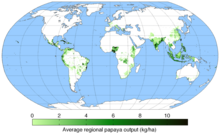
In 2022, global production of papayas was 13.8 milliontonnes,led by India with 38% of the world total (table). Global papaya production grew significantly over the early 21st century, mainly as a result of increased production in India and demand by the United States.[38]The United States is the largest consumer of papayas worldwide.[12]
In South Africa, papaya orchards yield up to 100 tonnes of fruit per hectare.[39]
Toxicity[edit]
Papaya releases a latex fluid when not ripe, possibly causing irritation and an allergic reaction in some people. Because the enzymepapainacts as anallergenin sensitive individuals,[40]meat that has been tenderized with it may induce anallergic reaction.[6]
Culinary use[edit]
The ripe fruit of the papaya is usually eaten raw, without skin orseeds.[6]The black seeds are edible and have a sharp, spicy taste.[6]The unripe green fruit is usuallycookeddue to itslatexcontent.
Both green papaya fruit and its latex are rich in papain,[6]a cysteine protease used for tenderizing meat and other proteins, as practiced currently byindigenous Americans,people of the Caribbean region, and thePhilippines.[6]It is included as a component in some powdered meat tenderizers.[6]Papaya is not suitable for foods which set due togelatin(such asjellyoraspic) because theenzymaticproperties of papain prevent gelatin from setting.[41]
-
Papaya juice
-
Papaya jam fromSenegal
Nutrition[edit]
| Nutritional value per 100 g (3.5 oz) | |
|---|---|
| Energy | 179 kJ (43 kcal) |
10.82 g | |
| Sugars | 7.82 g |
| Dietary fiber | 1.7 g |
0.26 g | |
0.47 g | |
| Vitamins | Quantity %DV† |
| Vitamin A equiv. | 5% 47 μg3% 274 μg89 μg |
| Thiamine (B1) | 2% 0.023 mg |
| Riboflavin (B2) | 2% 0.027 mg |
| Niacin (B3) | 2% 0.357 mg |
| Pantothenic acid (B5) | 4% 0.191 mg |
| Vitamin B6 | 2% 0.038 mg |
| Folate (B9) | 10% 38 μg |
| Vitamin C | 69% 62 mg |
| Vitamin E | 2% 0.3 mg |
| Vitamin K | 2% 2.6 μg |
| Minerals | Quantity %DV† |
| Calcium | 2% 20 mg |
| Iron | 1% 0.25 mg |
| Magnesium | 5% 21 mg |
| Manganese | 2% 0.04 mg |
| Phosphorus | 1% 10 mg |
| Potassium | 6% 182 mg |
| Sodium | 0% 8 mg |
| Zinc | 1% 0.08 mg |
| Other constituents | Quantity |
| Water | 88 g |
| Lycopene | 1828 µg |
| †Percentages estimated usingUS recommendationsfor adults,[42]except for potassium, which is estimated based on expert recommendation fromthe National Academies.[43] | |
Raw papaya pulp contains 88% water, 11%carbohydrates,and negligiblefatandprotein(table). In a 100-g amount, papaya fruit provides 43kilocaloriesand is a significant source ofvitamin C(75% of theDaily Value,DV) and a moderate source offolate(10% DV), but otherwise has a low content ofnutrients(see table).
Southeast Asia[edit]
This sectionneeds additional citations forverification.(September 2023) |
Green papaya is used inSoutheast Asiancooking, both raw and cooked. In some parts of Asia, the young leaves of the papaya aresteamedand eaten likespinach.
InMyanmar,the unripe papaya are cut into slices and dipped into sour, fermented, or spicy seasonings and dips. In Myanmar and Thai recipes, the unripe papaya are cut into thinner slices to make papaya salad.[44]The reason the unripe papaya is used is because of the firmer and crunchier texture.
Papayas became a part ofFilipino cuisineafter being introduced to the islands via theManila galleons.[45][46]Unripe or nearly ripe papayas (with orange flesh but still hard and green) arejuliennedand are commonly pickled intoatchara,which is ubiquitous as aside dishto salty dishes.[47]Nearly ripe papayas can also be eaten fresh asensaladang papaya(papaya salad) or cubed and eaten dipped in vinegar or salt. Green papaya is also a common ingredient or filling in various savory dishes such asokoy,tinola,ginataan,lumpia,andempanada,especially in the cuisines of northernLuzon.[48][49][50]
InIndonesian cuisine,the unripe green fruits and young leaves are boiled for use as part oflalabsalad, while the flower buds aresautéedandstir-friedwith chilies and green tomatoes asMinahasanpapaya flower vegetable dish.
InLaoandThaicuisine, unripe green papayas are used to make a type of spicy salad known in Laos astam maak hoongand in Thailand assom tam.It is also used inThai curries,such askaeng som.
-
Green papaya is a traditional main ingredient oftinolain thePhilippines.
South America[edit]
In Brazil and Paraguay, the unripe fruits are used to make sweets orpreserves.[citation needed]
Traditional medicine[edit]
Intraditional medicine,papaya leaves have been believed useful as a treatment formalaria,[51]anabortifacient,apurgative,or smoked to relieveasthma.[6]
See also[edit]
References[edit]
- ^Contreras, A. (2016)."Carica papaya".IUCN Red List of Threatened Species.2016:e.T20681422A20694916.Retrieved4 January2022.
- ^"Carica papayaL. "U.S. National Plant Germplasm System. 9 May 2011.Retrieved5 September2017.
- ^ab"Papaw".Collins Dictionary. n.d.Retrieved25 April2014.
- ^InNorth America,papawor pawpaw usually means the plant belonging to theAnnonaceaefamily or its fruit. Ref.:Merriam-Webster's Collegiate Dictionary(2009), published in United States.
- ^"CaricaL. "World Flora Online.World Flora Consortium. 2022.Retrieved17 November2022.
- ^abcdefghijklmnopqMorton JF (1987)."Papaya; In: Fruits of Warm Climates".Purdue University Center for New Crops and Plant Products. pp. 336–346.Retrieved27 October2023.
- ^abcdChávez-Pesqueira M, Núñez-Farfán J (1 December 2017)."Domestication and Genetics of Papaya: A Review".Frontiers in Ecology and Evolution.5.doi:10.3389/fevo.2017.00155.
- ^Harper D."papaya".Online Etymology Dictionary.Retrieved17 November2022.
- ^Harper D."papaw".Online Etymology Dictionary.Retrieved17 November2022.
- ^abcdHeywood V, Brummitt R, Culham A, et al. (2007).Flowering plant families of the world.Firefly Books.ISBN9781554072064.
- ^Ronse De Craene L (2010).Floral diagrams: an aid to understanding flower morphology and evolution.Cambridge: Cambridge University Press.ISBN978-0-521-49346-8.
- ^ab"Papayas"(PDF).Western Institute for Food Safety & Security, University of California at Davis. 2016.Retrieved10 September2017.
- ^abChia CL, Manshardt RM (October 2001)."Why Some Papaya Plants Fail to Fruit"(PDF).Fruits and Nuts.College of Tropical Agriculture and Human Resources, University of Hawaii at Manoa: 1–2.Retrieved1 April2015.
- ^"papaya | Description, Cultivation, Uses, & Facts".Encyclopedia Britannica.Retrieved2020-07-28.
- ^Rivera-Pastrana D, Yahia E, González-Aguilar G (2010). "Phenolic and carotenoid profiles of papaya fruit (Carica papayaL.) and their contents under low-temperature storage ".J Sci Food Agric.90(14): 2358–65.Bibcode:2010JSFA...90.2358R.doi:10.1002/jsfa.4092.PMID20632382.
- ^Rossetto M, Oliveira do Nascimento J, Purgatto E, et al. (2008). "Benzylglucosinolate, benzyl isothiocyanate, and myrosinase activity in papaya fruit during development and ripening".J Agric Food Chem.56(20): 9592–9.doi:10.1021/jf801934x.PMID18826320.
- ^Shen YH, Yang FY, Lu BG, et al. (2019-01-16)."Exploring the differential mechanisms of carotenoid biosynthesis in the yellow peel and red flesh of papaya".BMC Genomics.20(1): 49.doi:10.1186/s12864-018-5388-0.ISSN1471-2164.PMC6335806.PMID30651061.
- ^Seigler D, Pauli G, Nahrstedt A, et al. (2002). "Cyanogenic allosides and glucosides from Passiflora edulis and Carica papaya".Phytochemistry.60(8): 873–82.Bibcode:2002PChem..60..873S.doi:10.1016/s0031-9422(02)00170-x.PMID12150815.
- ^abcWard D (2011)."Papaya"(PDF).The Palmetto.Retrieved1 January2022.
- ^Gonsalves, D., Tripathi, S., Carr, J.B., et al. (2010)."Papaya ringspot virus".
- ^Hine B, Holtsmann O, Raabe R (July 1965)."Disease of papaya in Hawaii"(PDF).
- ^abcdeMossler M, Crane J (2008)."Florida crop/pest management profile: papaya"(PDF).University of Florida. Archived fromthe original(PDF)on 30 June 2017.
- ^Cunningham, B., Nelson, S. (June 2012)."Powdery mildew of papaya in Hawaii"(PDF).
- ^Sivinski J, Calkins C, Baranowski R, et al. (April 1996). "Suppression of a Caribbean Fruit Fly (Anastrepha suspensa(Loew) Diptera: Tephritidae) Population through Augmented Releases of the ParasitoidDiachasmimorpha longicaudata(Ashmead) (Hymenoptera: Braconidae)".Biological Control.6(2): 177–185.doi:10.1006/bcon.1996.0022.ISSN1049-9644.
- ^Duarte O PR (2010).Tropical Fruits, 1.Wallingford: CABI.
- ^Boning CR (2006).Florida's Best Fruiting Plants: Native and Exotic Trees, Shrubs, and Vines.Sarasota, Florida: Pineapple Press, Inc. pp. 166–167.
- ^"Papaya Varieties".Papaya Australia. 2015. Archived fromthe originalon 6 February 2016.Retrieved9 December2015.
- ^Sagon C (13 October 2004)."Maradol Papaya".Market Watch (13 Oct 2004).The Washington Post.Retrieved21 July2011.
- ^Siar SV, Beligan GA, Sajise AJ, et al. (2011). "Papaya ringspot virus resistance in Carica papaya via introgression from Vasconcellea quercifolia".Euphytica.181(2). SpringerLink: 159–168.doi:10.1007/s10681-011-0388-z.S2CID40741527.
- ^abOrdaz-Pérez D, Gámez-Vázquez J, Hernández-Ruiz J, et al. (2 September 2017)."Resistencia de Vasconcellea cauliflora al Virus de la mancha anular de la papaya-potyvirus (PRSV-P) y su introgresión en Carica papaya".Revista Mexicana de Fitopatología, Mexican Journal of Phytopathology.35(3).doi:10.18781/r.mex.fit.1703-4.
- ^Borrell (2008)."Papaya genome project bears fruit".Ugr.es.doi:10.1038/news.2008.772.
- ^"Genetically Altered Papayas Save the Harvest".mhhe.com.
- ^"Hawaiipapaya.com".Hawaiipapaya.com. Archived fromthe originalon 2015-01-07.Retrieved2013-06-15.
- ^Ronald, Pamela and McWilliams, James (14 May 2010)Genetically Engineered DistortionsThe New York Times, accessed 1 October 2012
- ^"TF5"(PDF).Archived fromthe original(PDF)on March 31, 2012.
- ^Mishra R, Gaur RK, Patil BL (2016). "Current Knowledge of Viruses Infecting Papaya and Their Transgenic Management".Plant Viruses: Evolution and Management.pp. 189–203.doi:10.1007/978-981-10-1406-2_11.ISBN978-981-10-1405-5.
- ^"Papaya production in 2022; Crops/Regions/World list/Production Quantity/Year (pick lists)".UN Food and Agriculture Organization,Corporate Statistical Database (FAOSTAT). 2024.Retrieved4 March2024.
- ^"An Overview of Global Papaya Production, Trade, and Consumption".Electronic Data Information Source, University of Florida.Retrieved2014-02-07.
- ^Botha L (16 March 2021)."Growing papayas: Easy to produce, tricky to market".Farmer's Weekly.Retrieved11 March2023.
- ^"Papain".National Library of Medicine, US National Institutes of Health. 27 April 2019.Retrieved29 April2019.
- ^Donna Pierce (2006-01-18)."Papaya".The Chicago Tribune.Retrieved2020-06-04.
- ^United States Food and Drug Administration(2024)."Daily Value on the Nutrition and Supplement Facts Labels".FDA.Archivedfrom the original on 2024-03-27.Retrieved2024-03-28.
- ^National Academies of Sciences, Engineering, and Medicine, Health and Medicine Division, Food and Nutrition Board, et al. (2019). Oria M, Harrison M, Stallings VA (eds.).Dietary Reference Intakes for Sodium and Potassium.The National Academies Collection: Reports funded by National Institutes of Health. Washington, DC: National Academies Press (US).ISBN978-0-309-48834-1.PMID30844154.Archivedfrom the original on 2024-05-09.Retrieved2024-06-21.
- ^"Burmese Papaya Salad (Myanmar Food)".YouTube.
- ^Alonso N (15 September 2009)."First Taste Of Mexican Cuisine".PhilStar Global.Retrieved15 December2018.
- ^"Champorado and the Manila Galleon Trade".Ariana Eats Lumpia.Archived fromthe originalon 15 August 2018.Retrieved15 December2018.
- ^"Achara".SBS TV.4 December 2014.Retrieved15 December2018.
- ^"The green papaya in Filipino cuisine".Glossary of Filipino Food...and essays on the world's "original fusion cuisine" too.Retrieved15 December2018.
- ^"What to eat in Philippines?".FoodYouShouldTry.com.26 October 2017.Retrieved15 December2018.
- ^"Green Papaya Recipe".Vegetarian Yums.Archived fromthe originalon 20 November 2021.Retrieved15 December2018.
- ^Titanji, V.P., Zofou, D., Ngemenya, M.N. (2008)."The Antimalarial Potential of Medicinal Plants Used for the Treatment of Malaria in Cameroonian Folk Medicine".African Journal of Traditional, Complementary and Alternative Medicines.5(3): 302–321.PMC2816552.PMID20161952.
External links[edit]
- IUCN Red List data deficient species
- Papaya
- Caricaceae
- Crops originating from Mexico
- Crops originating from the Americas
- Flora of Mexico
- Flora of Central America
- Flora of Venezuela
- Flora of Colombia
- Fruits originating in North America
- Tropical fruit
- Trees of Central America
- Trees of South America
- Plants described in 1753
- Medicinal plants of Central America
- Garden plants of Central America
- Garden plants of South America
- Ornamental trees
- Tropical agriculture
- Cauliflory
- Crops originating from indigenous Americans









